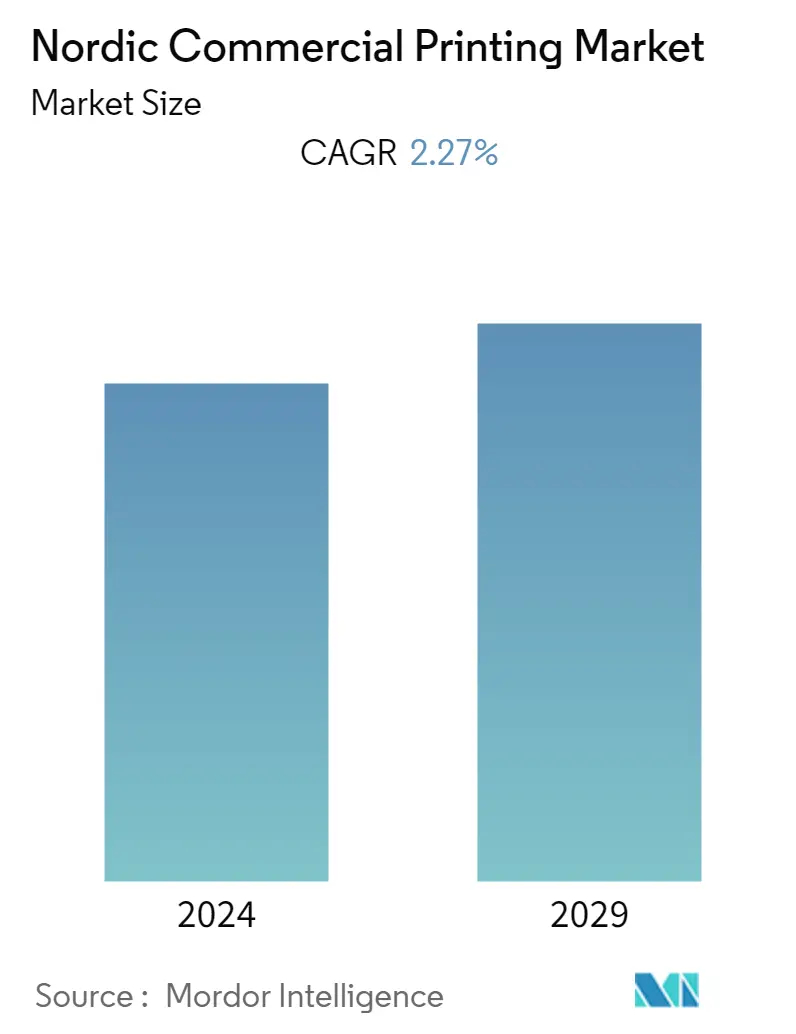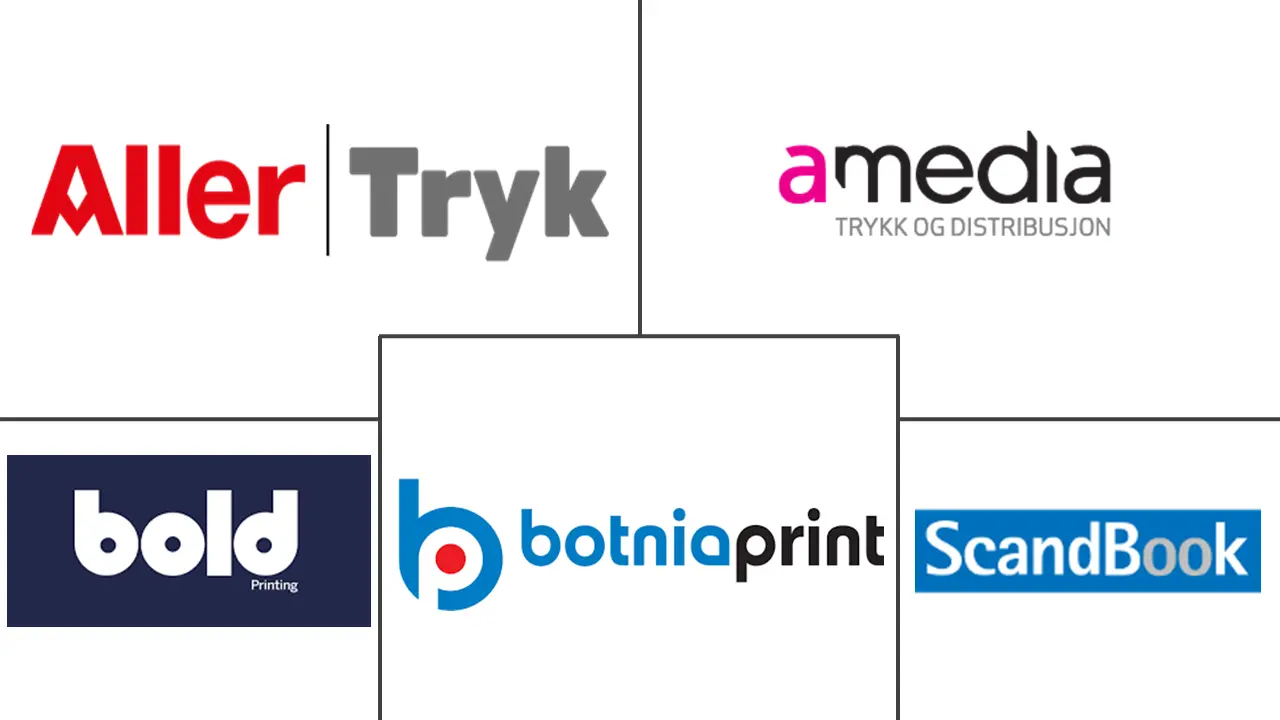Market Size of Nordic Commercial Printing Industry

| Study Period | 2019 - 2029 |
| Base Year For Estimation | 2023 |
| Forecast Data Period | 2024 - 2029 |
| Historical Data Period | 2019 - 2022 |
| CAGR | 2.27 % |
| Market Concentration | Low |
Major Players
*Disclaimer: Major Players sorted in no particular order |
Nordic Commercial Printing Market Analysis
The Nordic Commerical Printing Market is expected to register a growth at a CAGR of 2.27% over the forecast period (2021-2026). Technological proliferation along with rising applications across multiple end-use segments is anticipated to encourage the demand for commercial printing prints on materials such as business forms, financial printing, and training manuals in the Nordic countries. Advertising and the product needs of business customers drive demand for high-quality printing jobs.
- Commercial printing covers a broad range of materials including product manuals, catalogs, direct mail, books, and transactional purposes. For large print runs, offset printing - which includes the creation of print plates - remains the principal means. However, there is a burgeoning requirement for digital printing, which does not need plates and is nimble enough for short-run production in a wide variety of applications and fast turnaround.
- The increase in the consumption of printed media is creating new opportunities for the vendors in the region. According to Danish Broadcasting Corporation (DR), in Denmark, the printed media consumption increased from 5% in 2019 to 6% in 2020.
- The lithographic process is observed to be dominating the retail print industry but is expected to suffer market share to methods such as digital prints that are entirely suited to shorter print runs. Application segments include advertising, office products, catalogs, periodicals, labels and wrappers, and directories. Furthermore, it can be used to print garments, books, & other fabrics, documents, financial & legal forms, catalogs, & directories simultaneously with office products.
- As the printing industry is a supplier to many other economic sectors, the emergence of COVID-19 outbreak across the globe is significantly impacting the commercial printing industry in the region. The first impact can be considered on the commercial printing companies supplying to trade fairs/exhibitions or meetings and events; and large amount of which got cancelled at the last moment.
- Furthermore, due to the change in the consumer behavior during pandemic, the trends of online are expected to be there post pandemic. However, as things reopen and get back to normal, the need for commercial printing is expected to increase as printing helps in engaging consumers and leveraging new revenue opportunities in advertising industry.
Nordic Commercial Printing Industry Segmentation
The study analyzes the current market demand and growth forecasts for the key segments within the commercial printing market such as print process type, applications in packaging, advertising, and publishing, among others, and geographical analysis in the Nordic countries.
A commercial printer is used to create phone books, magazines, catalogs, brochures, labels, business forms, promotional materials, and training manuals, among others. It consists of a paper feed, ink replacer, digital or analog control panel, fold-out tray, memory card reader, and a paper output tray. It finds extensive applications over publishing and printing houses, as well as in big companies that utilize the service to run their facilities and operations efficiently.
| By Type | |
| Offset Lithography | |
| Inkjet | |
| Flexographic | |
| Screen | |
| Gravure | |
| Other Types |
| By Application | |
| Packaging | |
| Advertising | |
| Publishing | |
| Other Applications |
| By Geography | |
| Sweden | |
| Norway | |
| Finland | |
| Denmark | |
| Rest of Nordic Region |
Nordic Commercial Printing Market Size Summary
The Nordic commercial printing market is poised for growth, driven by technological advancements and increasing applications across various end-use segments. The demand for high-quality printing jobs is primarily fueled by advertising and the product needs of business customers. Commercial printing encompasses a wide range of materials, including product manuals, catalogs, direct mail, and transactional documents. While offset printing remains the dominant method for large print runs, digital printing is gaining traction due to its flexibility and efficiency for short-run productions. The rise in printed media consumption presents new opportunities for vendors, despite challenges posed by the COVID-19 pandemic, which initially disrupted supply chains and consumer behavior. As the market recovers, the need for commercial printing is expected to rise, leveraging new revenue opportunities in the advertising sector.
Digital printing technologies are transforming the commercial printing landscape, offering advantages such as on-demand production, reduced emissions, and improved print accuracy. The adoption of inkjet printing, including thermal and piezoelectric drop-on-demand technologies, is enhancing the ability to produce short runs and unique products efficiently. This shift is encouraging printing houses to invest in advanced digital printing technologies to attract new customers and streamline operations. The Nordic region, traditionally strong in newspaper circulation, is experiencing a shift towards digital alternatives, with online newspaper readership increasing. The market is highly competitive, with numerous international and regional players, and companies are pursuing strategic mergers and acquisitions to enhance their market share. Despite challenges like overcapacity and pricing pressures, the market remains dynamic, with a focus on sustainability and innovation.
Nordic Commercial Printing Market Size - Table of Contents
-
1. MARKET INSIGHTS
-
1.1 Market Overview
-
1.2 Industry Value Chain Analysis
-
1.3 Industry Attractiveness - Porter's Five Force Analysis
-
1.3.1 Bargaining Power of Suppliers
-
1.3.2 Bargaining Power of Buyers/Consumers
-
1.3.3 Threat of New Entrants
-
1.3.4 Threat of Substitute Products
-
1.3.5 Intensity of Competitive Rivalry
-
-
1.4 Assessment of the COVID-19 impact on the market
-
-
2. NORDIC COMMERCIAL PRINTING MARKET SEGMENTATION
-
2.1 By Type
-
2.1.1 Offset Lithography
-
2.1.2 Inkjet
-
2.1.3 Flexographic
-
2.1.4 Screen
-
2.1.5 Gravure
-
2.1.6 Other Types
-
-
2.2 By Application
-
2.2.1 Packaging
-
2.2.2 Advertising
-
2.2.3 Publishing
-
2.2.4 Other Applications
-
-
2.3 By Geography
-
2.3.1 Sweden
-
2.3.2 Norway
-
2.3.3 Finland
-
2.3.4 Denmark
-
2.3.5 Rest of Nordic Region
-
-
Nordic Commercial Printing Market Size FAQs
What is the current Nordic Commercial Printing Market size?
The Nordic Commercial Printing Market is projected to register a CAGR of 2.27% during the forecast period (2024-2029)
Who are the key players in Nordic Commercial Printing Market?
Aller Tryk A/S, amedia trykk og distribusjon, Bold Printing Group AB, Botnia Print and ScandBook Holding are the major companies operating in the Nordic Commercial Printing Market.

